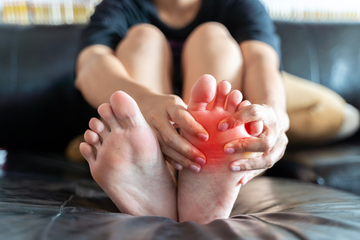Rheumatoid arthritis (RA) is an autoimmune disorder that affects joints, causing chronic inflammation, pain, and sometimes even joint damage. It commonly affects the hands and knees but can also impact the feet, which are often overlooked. Knowing the signs of RA in your feet can help you get treatment early and avoid further damage.
Persistent Foot Pain

One of the first and most common signs of RA in the feet is persistent pain, often centered in the ball of the foot or toes. It might feel like soreness after a long walk, but unlike regular fatigue, this pain doesn’t go away with rest. This discomfort typically comes from inflammation in the smaller joints of the foot. Over time, the pain may become more severe and even affect walking and balance.
Swelling and Redness
Swelling is another symptom of RA in the feet. Inflammation around the joints can cause your feet to appear puffier than usual. Due to increased blood flow and inflammation, the affected areas may also look red and feel warm to the touch. This can make it hard to wear shoes, and your regular shoes might feel too tight.
Stiffness in the Morning
Joint stiffness is a hallmark of rheumatoid arthritis and often affects the feet. If your feet feel stiff and hard to move, especially in the morning or after resting, it could be a sign of RA.
Joint Deformities
As RA gets worse, it can damage the bones, cartilage, and tissues in the foot. This damage can cause visible changes in the toes, like hammer toes or bunions. One common problem is when the big toe bends toward the other toes, forming a bump on the side of the foot. Another issue is claw toe, where the toes curl unusually because of joint and tendon changes.
Numbness and Tingling
RA can sometimes press on nerves in the feet, causing numbness, tingling, or a burning feeling. This happens because swelling or joint changes put pressure on the nerves. If you notice these symptoms, see a healthcare professional for advice and treatment.
Difficulty Walking
As rheumatoid arthritis in the feet gets worse, pain, swelling, and joint damage can make it hard to walk. You may have an altered gait or are limping more often. RA can also lead to issues with balance, making you more prone to falls.
Fatigue and Generalized Symptoms
Rheumatoid arthritis doesn’t just affect the feet. It can cause symptoms throughout the whole body. Fatigue and a low-grade fever are common. These can make it harder to cope with foot pain and other issues. If you notice fatigue with any foot symptoms, it may be time to get checked out by your doctor.
What If You Have Symptoms?
If you have any of these symptoms, see a healthcare provider for a proper evaluation. Early diagnosis is important to manage rheumatoid arthritis. Treatment can help prevent long-term joint damage. Treatment options may include medications like NSAIDs or corticosteroids. Physical therapy and customized footwear can also help ease pain and improve mobility.
Tips for Managing Symptoms in the Feet
- Wear Supportive Footwear: Pick shoes with good arch support and cushioning to ease pressure on your joints.
- Use Orthotics: Custom insoles can support your feet and reduce pain from joint changes.
- Practice Foot Exercises: Stretch and strengthen your feet to keep them flexible and reduce stiffness.
- Rest and Ice: Rest your feet and apply ice to reduce swelling and pain.
Rheumatoid arthritis in the feet can be painful and hard to deal with. Knowing the symptoms can help you manage it. You can seek medical advice before the condition progresses by recognizing the early signs of RA, such as pain, swelling, and numbness. With proper treatment, many people with RA can stay active and live normal lives!






















